stop start AUDI S3 2016 Owner's Manual
[x] Cancel search | Manufacturer: AUDI, Model Year: 2016, Model line: S3, Model: AUDI S3 2016Pages: 328, PDF Size: 81.78 MB
Page 92 of 328

Automat ic t ra nsm iss io n
-Never select R or P while driving, because
this increases the risk of an accident.
- Power is still transmitted to the wheels
when the engine is running at idle. To pre
vent the vehicle from "creeping" , you must
keep your foot on the brake in all selector
lever positions (except P) when the engine is
running. Otherwise, this increases the r isk
of an accident.
- Do not inadvertently press the accelerator
pedal when the veh icle is stopped if a gear is
engaged. Otherwise the vehicle will start to
move immediately, even if the parking brake
is set. This cou ld result in a crash.
- Do not press the accelerator pedal when
changing the selector lever position wh ile
the vehicle is stationary and the engine is running .
- Never leave yo ur vehicle with the engine
running whi le in gear. If you must leave
your vehicle when the engine is running, set
the parking brake and move the selector lev
er to the P position.
- To decrease the risk of an accident, these
lector lever must be in the P position and
the parking brake must be set before open ing the hood and working on a running en
gine . Always read and follow the applicable
warnings
q page 236, Working in the en
gine compartment.
(D Note
Never let the veh icle roll downhill with engine
off and the selector lever in the
N position,
because this could damage the automatic
transmission and catalytic converter .
(D Tips
-Audi drive select: Sporty shifting character
i stics can be selected us ing the
D ynami c
driving mode.Swill appear in the instru
ment cluster disp lay instead of D.
- Plug-in hybrid drive*: the transm iss ion
switc hes automatically to the normal D
mode if the
l a ' I butto n ¢ page 104 is p ress
ed while in spo rt mode 5 .
90
-If you accidentally select N whi le dr iving,
take your foot off the accelerator peda l im
mediately and wait for the eng ine to slow
down to idle before selecting Dor
5.
- If there is a power failure, the selector lever
will not move out of the P position. The
emergency release can be used if this hap
pens ¢
page 96.
Selector lever lock
Applies to vehicles: with S tronic transmiss ion
The sele ctor lever lock prevents you from select
ing a gear accidentally, causing the vehicle to
roll .
Fig. 82 Selecto r lever lock
To release the se lector lever lock :
.,. Sw itch on the ignition .
12 0
0
> Q) a)
.,. Press the brake pedal while pressing the in ter-
lock button.
Automat ic shift lock (ASL )
The selector lever is locked in the P and N posi
tions when the ign it ion is switched on. You must
press the brake peda l to select another position .
You must also press the in terlock button if you
are moving from the P posi tion . The follow ing
message appears in the d isp lay when the se lector
lever is in the P or N posit ion to rem ind the driv
er:
When stati onar y ap pl y fo otbrake while select
ing ge ar
The automatic sh ift lock only functions when the
vehicle is stationa ry or at speeds be low 1 mph
(2 km/h) . At highe r speeds, the lo ck is automati-
ca lly deactiva ted in the N pos ition . ..,.
Page 93 of 328

.... N
0 > CX)
.... I.Cl U"I
.... I.Cl ....
The selector lever is not locked when shifting
quickly through N, for examp le from R to D . This
makes it poss ible to free the vehicle when it is
stuck by "rocking" it . The selecto r lever lock en
gages if the lever stays in the N position longer
than approximately 2 seconds when the brake
pedal is not pressed .
Interlock button
The interlock button in the selector lever handle
prevents you from moving the selector lever in
adverten tly while in some sele ctor lever posi
tions . The posit ions that require the lock button
to be pressed are marked in color in the illustra
tion
¢ fig . 82 .
Ignition key safety interlock*
You can only remove the key from the ignition af
ter switching the ignition off if the selec tor lever
is in the P position . The selector lever will be
l ocked in the P pos ition as long as the key is not
in the ignition .
.&, WARNING
Read and follow all WARNINGS.¢ & in Selec
tor lever positions on page 89.
{O) Tips
-If the select or lever does not engage, there
i s a malfunction. The eng ine is disabled to
prevent the vehicle from driving off unin
tentionally. Press the brake pedal briefly to
allow the selector lever lock to engage
again.
- If the vehicle does not move forward or in
reverse even though a drive position is se
l ected, proceed as follows:
->If the veh icle does not move in t he desired
direction, the system may not have engaged
the drive position correctly. Press the brake
pedal and select the drive position again .
-> If the vehicle still does not move in the de
sired direction, there is a system malfunc
tion. See an authorized Audi dealer or au
thorized Audi Service Facility for assistance
to have the system checked.
Automatic transmission
Driving tips
Applies to vehicles : wit h S t ronic transmiss ion
T he transmission shifts up and down automati
cally when in the driving gears .
Fig. 83 Section of t he center conso le: sel ector leve r wit h
inte rlock butto n
The engine will only be able start when the selec
tor lever is in the P or N pos itions . At low temper
atures (below 14 °F (-10 °()), the eng ine can only
be started when the selector lever is in the P po
sition.
Starting from a stop
.,. Press and hold the brake pedal.
.,. Press and hold the interlock butto n in these
lector lever handle, select the desired selector
lever position such as D ¢
page 89 and release
t he lock button.
.,. Wait a moment until the transmission shifts.
You w ill not ice a slight movement when the
gear engages .
.,. Release the brake pedal and press the accelera
tor pedal ¢&, .
Stopping temporarily
.,. Keep the vehicle stationary using the braking
pedal, for examp le at traffic lights.
.,. Do not press the accelerator pedal when doing
this .
.,. To prevent the vehicle from rolling when you
start driving, set the parking brake when stop
ping on steep incl ines ¢&, .
.,. The parking brake will release automat ically
and the vehicle will start moving once yo u press
the acce le rator pedal. Requirement: the driv
er 's doo r must be closed and the driver's safety
be lt must be fastened . ..,.
91
Page 94 of 328
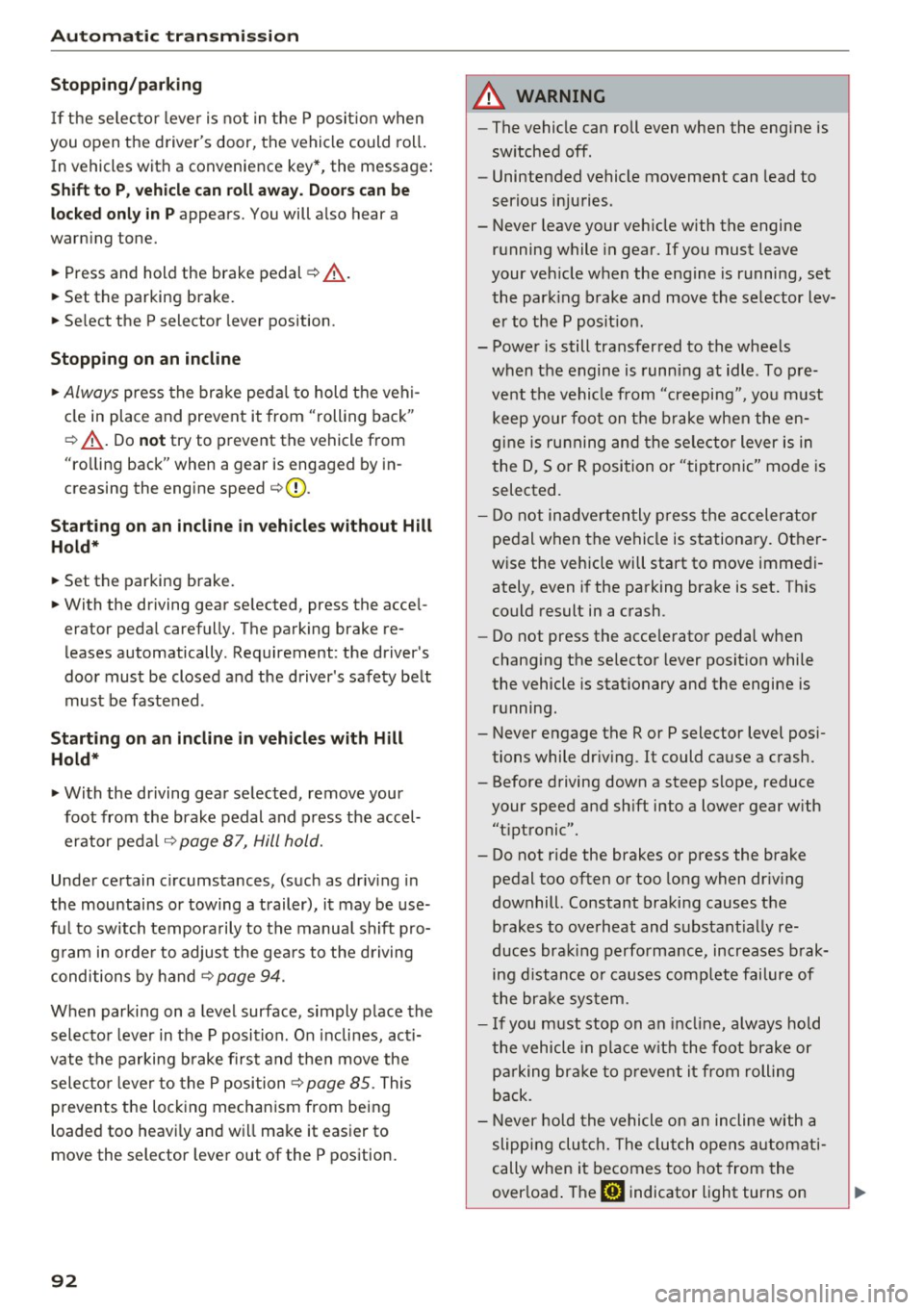
Automatic transmissio n
Stopp ing /park ing
If the se lecto r lever is not in the P posit ion when
you open the driver's door, the vehicle could roll .
In vehicles with a convenience key*, the message:
Shift to P , vehicle can roll away . Doors c an be
lo cked onl y in P
appears. You will a lso hear a
warn ing tone.
... Press and hold the brake pedal¢_&. .
... Set the parking brake.
.,. Se lect the P selector lever position.
Stopp ing on an inclin e
.,. Always press the brake peda l to hold the vehi
cle in place and prevent it from "rolling back"
¢ _&. . Do
not try to prevent the vehicle from
"ro lling back" when a gear is engaged by in
creasing the engine speed ¢(D.
Starting on an inclin e in vehicl es without Hill
H old *
... Set the parking brake.
.,. With the driving gear selected, press the acce l
erator pedal carefully. The parking brake re
leases automatically . Requirement : the driver's
door must be closed and the driver's safety belt must be fastened .
Starting on an incline in veh icles with Hill
Hold*
.,. With the driving gear selected, remove your
foot from the brake pedal and press the accel
erator pedal~
page 87, Hill hold.
Under certain c ircumstances, (such as driv ing in
the mountains or towing a trailer), it may be use
fu l to sw itch temporarily to the manua l shift p ro
g ram in o rde r to adjust the gea rs to the driving
conditions by hand
c:? page 94.
When parking on a level surface, simply place the
selecto r leve r in the P position. On inclines, act i
vate the parking brake first and then move the
selector lever to the P posi tion
~ page 85. This
prevents the loc king mechanism from being
loaded too heav ily and wi ll make it easier to
move the selector lever out of the P position.
92
A WARNING
- The vehicle can roll even when the engine is
sw itched off.
- Unintended vehicle movement can lead to
serious injuries.
- Never leave your veh icle with the engine
running while in gear. If you must leave
your veh icle when the engine is running, set
the park ing brake and move the selector lev
er to the P posit ion.
- Power is still transferred to the wheels when the engine is running at idle . To pre
vent the vehicle from "creeping", yo u must
keep your foot on t he b rake when the en
gine is ru nning and the selector lever is in
the D, Sor R position or "tip tronic" mode is
selected.
- Do not inadve rten tly p ress the accelerator
pedal when the vehicle is stationary. Other
wise the vehicle will start to move immedi
ately, even if the parking brake is set. This
could result in a crash.
- Do not press the acce lerator pedal when
changing the selector lever posit ion while
the vehicle is stat ionary and the engine is
running.
- Never engage the R or P selector level pos i
tions while dr iv ing. It could cause a crash.
- Before driving down a steep slope, reduce your speed and shift into a lower gear w ith
"t i ptronic".
- Do not ride the brakes or press the brake pedal too often o r too long when dr iv ing
downhill. Constant braking causes the brakes to overheat and substant ially re
duces bra king performance, increases b rak
ing d istance or causes comp lete failure of
the bra ke sys tem.
- If you must stop on an incline, always hold
the vehicle in place w ith the foot brake or
p ar king bra ke to p revent it from rolling
back.
- Never hold the vehicle on an incline with a
slipping clu tch. The clutch opens automati
cally when it becomes too hot from the
over load . T he
l§1 indicator light turns on
Page 95 of 328
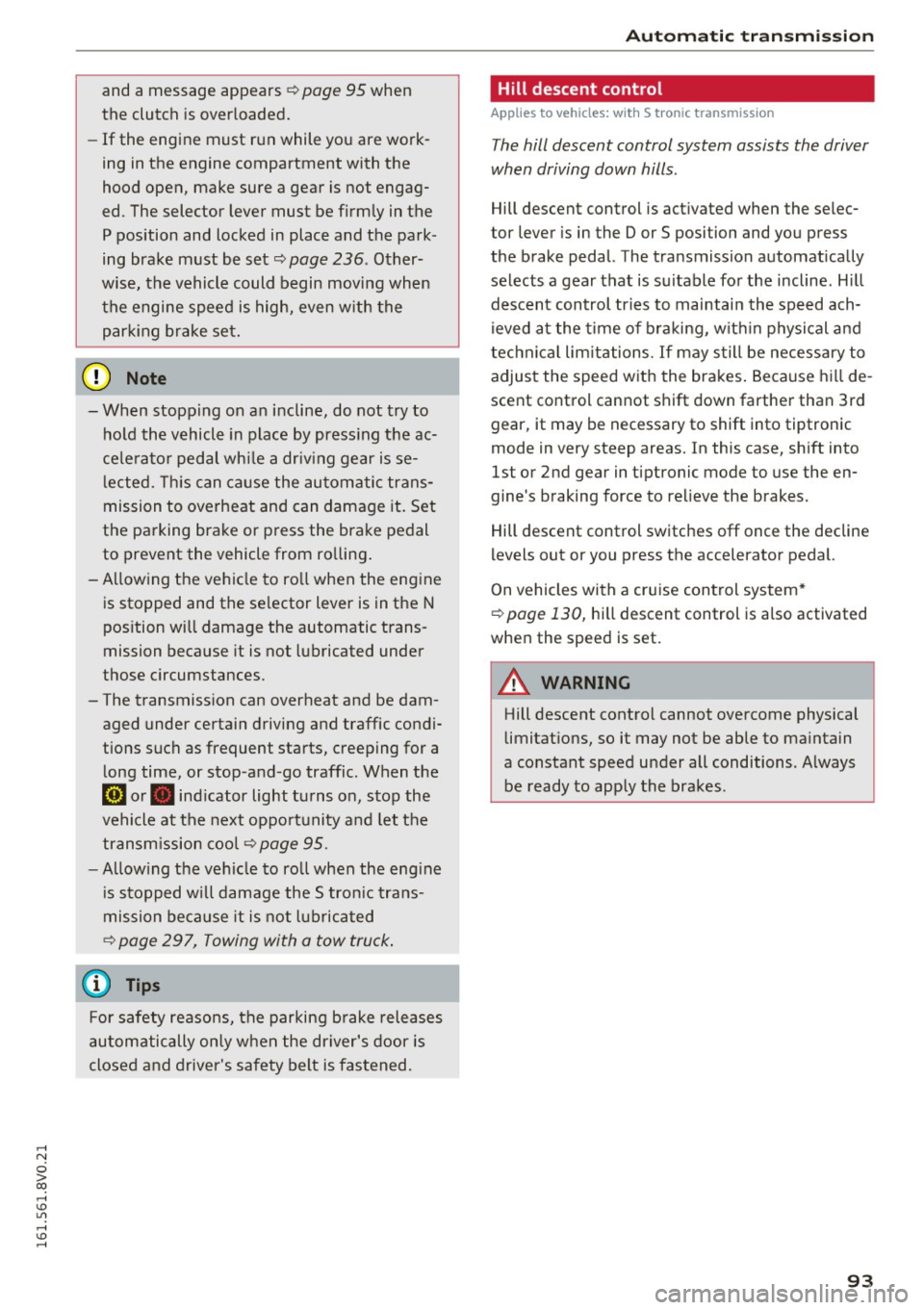
,....,
N
0 > co ,....,
the clutch is over loaded.
- If the engine must run while you are work
ing in the engine compartment with the
hood open, make sure a gear is not engag
ed. The selector lever must be firmly in the
P position and locked in place and the park
ing brake must be set¢
page 236. Other
w ise, the vehicle could begin moving when
the engine speed is high, even w ith the
par king brake set.
(D Note
- When stopping on a n incline, do not t ry to
ho ld the vehicle in place by press ing the ac
ce le ra to r pedal wh ile a driv ing gear is se
l ected. This can ca u se the au toma tic trans
mission to overheat and can damage it. Set
the pa rking brake or press the brake pedal
to prevent the vehicle from ro lling .
- Allow ing the vehicle to ro ll when the eng ine
is stopped and the se lector lever is in the N
pos ition w ill damage the automatic trans
mission because it is not l ubricated under
those circumstances.
- The transmiss ion can overheat and be dam
aged under certain driving and traffic condi
tions such as frequent starts , creeping for a
l ong time, or stop-and-go traffic. When t he
mJ o r. indicator light tu rns o n, s top the
vehicle at the next oppo rt u nity and let the
transm issio n coo l
¢page 95 .
-Allow ing the ve hicle to ro ll when the eng ine
i s s topped w ill damage the S tro nic trans
mission because it is not lubric ated
¢ page 297, Towing with a tow truck .
(D Tips
For safety reasons, the parking b rake releases
au tomatically on ly w hen the dr iver's door is
closed and driver's sa fe ty belt is fastened.
Autom atic tran sm iss ion
Hill descent control
Applies to vehicles: with S tronic transmission
The hill descent control system assists the driver
when driving down hills.
Hill descent control is act ivated when the se lec
tor lever is in the D or S position and you press
the brake pedal. The transmission automatically
selects a gear that is su itable for the incline . H ill
descent con trol tr ies to maintain the speed ach
i eved a t the time of braking, w it hi n physi cal a nd
technical lim itations . If may s till be necessary to
adjus t the speed w ith the bra kes . Because hill de
scent control cannot shift down farthe r than 3rd
gear, it may be necessary to shift into tiptronic
mode in very steep areas. In this case, shift into 1st or 2nd gear in tiptronic mode to use the en
gine's braking force to relieve the brakes .
Hill descent control switches off once the decline
levels out or you press the accelerator pedal.
On vehicles with a cru ise con trol system*
¢ page 130, hill descent control is a lso activated
when the speed is set.
A WARNING
-Hill descent control cannot overcome physical
limitat ions, so it may not be able to ma intain
a constant speed under all conditions. A lways
be ready to app ly the brakes.
93
Page 101 of 328
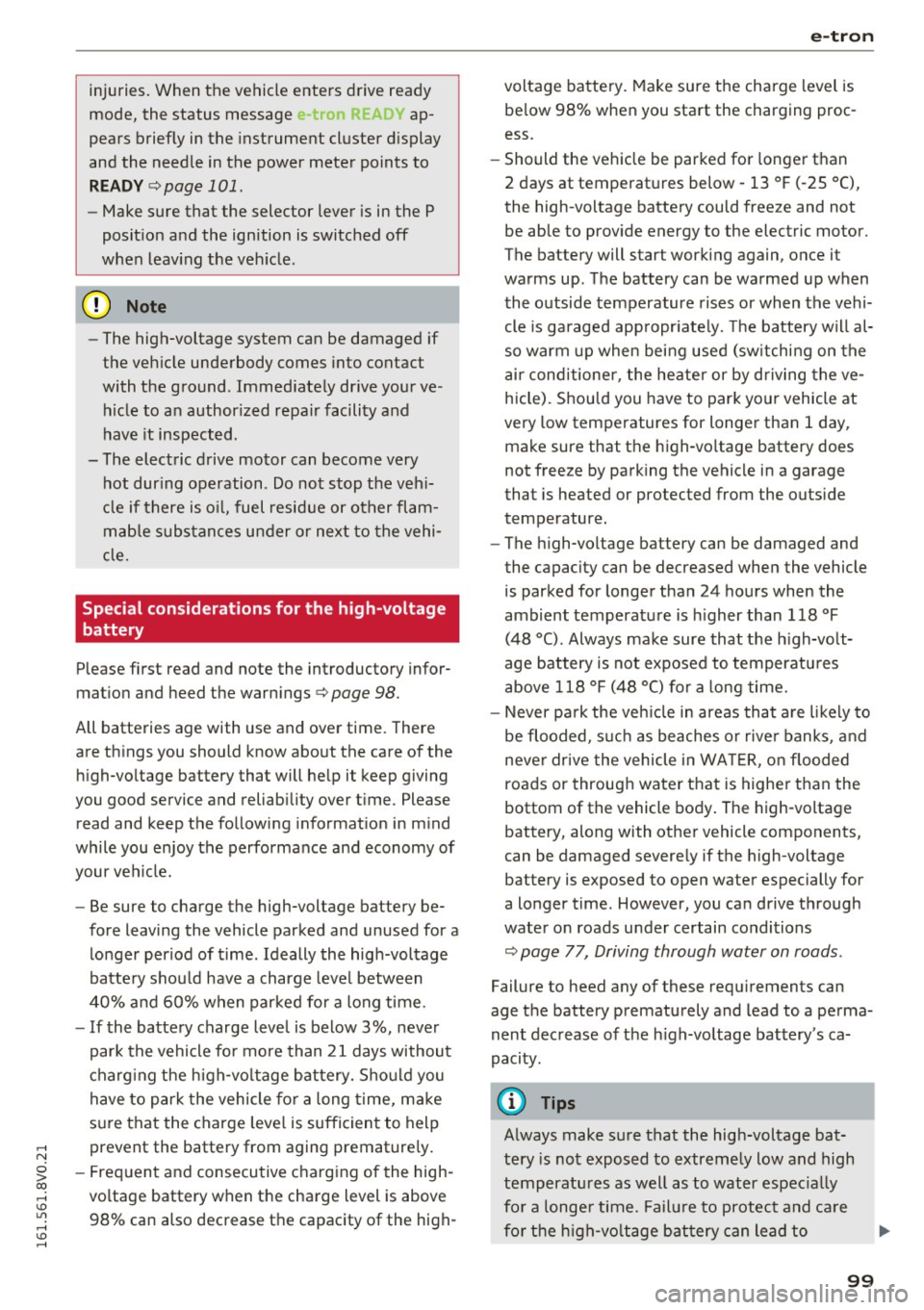
,....,
N
0 > co ,....,
mode, the status message
e-"'1 o I r.-.Al"'Y ap
pears briefly in the instrument cluster display
and the needle in the power meter points to
READY ¢page 101.
-Make sure that the selector lever is in the P
position and the ignition is switched off
when leaving the vehicle.
([) Note
-The high-voltage system can be damaged if
the vehicle underbody comes into contact
with the ground. Immediately drive your ve
hicle to an authorized repair facility and
have it inspected.
- The electric drive motor can become very
hot during operation . Do not stop the vehi
cle if there is oil, fuel residue or other flam
mable substances under or next to the vehi
cle.
Special considerations for the high-voltage
battery
Please first read and note the introductory infor
mation and heed the warnings
¢page 98.
All batteries age with use and over time. There
are things you should know about the care of the
high-voltage battery that will help it keep giving
you good service and reliability over time. Please
read and keep the following information in mind
while you enjoy the performance and economy of
your vehicle.
- Be sure to charge the high-voltage battery be
fore leaving the vehicle parked and unused for a
longer period of time. Ideally the high-voltage
battery should have a charge level between
40% and 60% when parked for a long time.
- If the battery charge level is below 3%, never
park the vehicle for more than 21 days without
charging the high-voltage battery. Should you
have to park the vehicle for a long time, make
sure that the charge level is sufficient to help
prevent the battery from aging prematurely.
- Frequent and consecutive charging of the high
voltage battery when the charge level is above
98% can also decrease the capacity of the high-
e-tron
voltage battery. Make sure the charge level is
below 98% when you start the charging proc
ess.
- Should the vehicle be parked for longer than
2 days at temperatures below -13 °F (-25 °(),
the high-voltage battery could freeze and not
be able to provide energy to the electric motor.
The battery will start working again, once it
warms up . The battery can be warmed up when
the outside temperature rises or when the vehi
cle is garaged appropriately. The battery will al
so warm up when being used (switching on the
air conditioner, the heater or by driving the ve
hicle). Should you have to park your vehicle at
very low temperatures for longer than 1 day,
make sure that the high-voltage battery does
not freeze by parking the vehicle in a garage
that is heated or protected from the outside
temperature.
- The high-voltage battery can be damaged and
the capacity can be decreased when the vehicle
is parked for longer than 24 hours when the
ambient temperature is higher than 118 °F
(48 °C). Always make sure that the high-volt
age battery is not exposed to temperatures
above 118 °F (48 °C) for a long time.
- Never park the vehicle in areas that are likely to
be flooded, such as beaches or river banks, and
never drive the vehicle in WATER, on flooded
roads or through water that is higher than the
bottom of the vehicle body. The high-voltage
battery, along with other vehicle components,
can be damaged severely if the high-voltage
battery is exposed to open water especially for
a longer time. However, you can drive through
water on roads under certain conditions
¢ page 77, Driving through water on roads .
Failure to heed any of these requirements can
age the battery prematurely and lead to a perma
nent decrease of the high-voltage battery's ca
pacity.
(D Tips
Always make sure that the high-voltage bat
tery is not exposed to extremely low and high
temperatures as well as to water especially
for a longer time. Failure to protect and care
for the high-voltage battery can lead to
99
Page 102 of 328
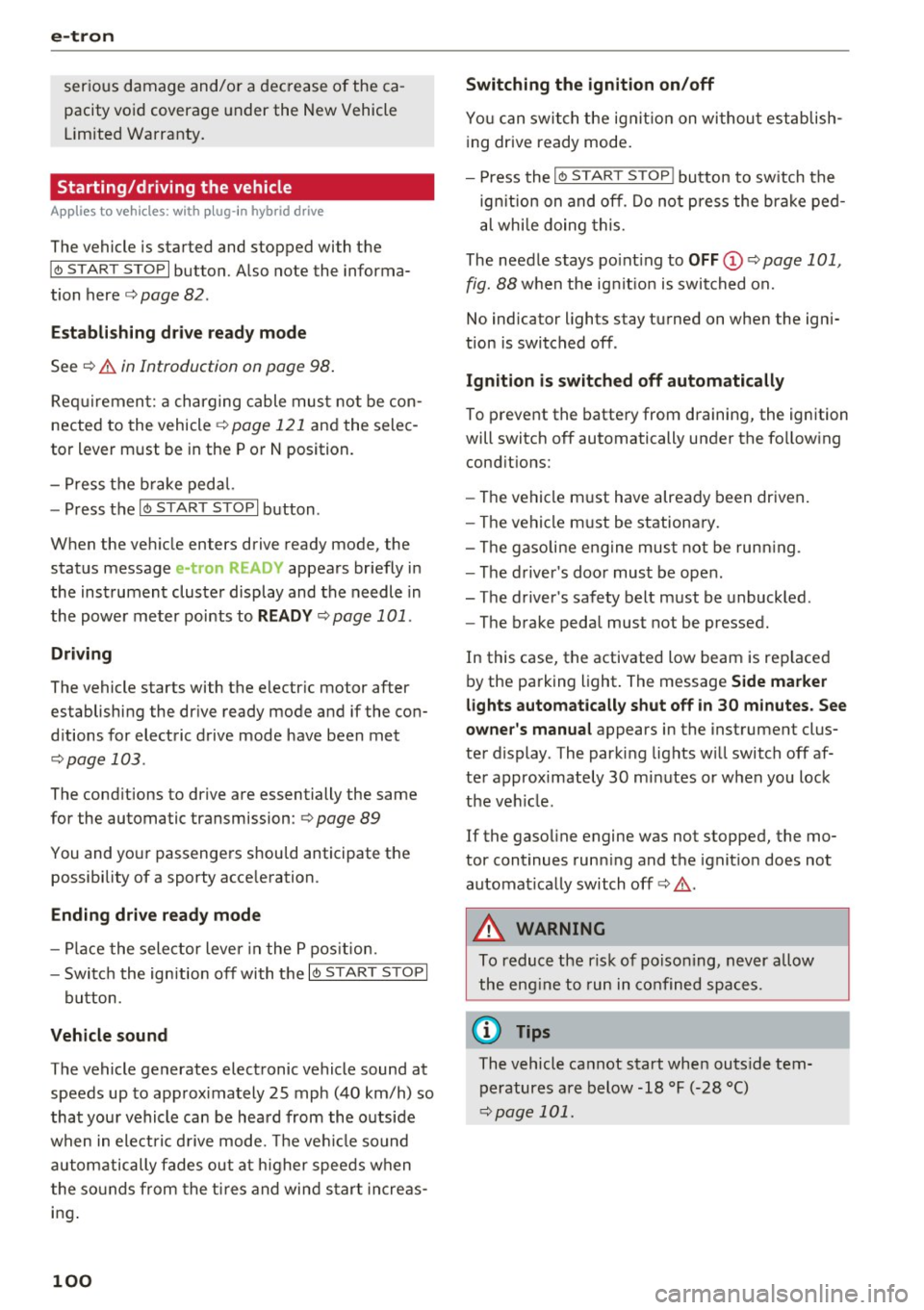
e-tron
serious damage and/or a decrease of the ca
pacity void coverage under the New Vehicle
Limited Warranty.
Starting/driving the vehicle
Applies to veh icles: w ith plug-in hybrid drive
The vehicle is started and stopped with the
I START S TOP I button. Also note the informa
tion here ¢
page 82.
Establishing drive ready mode
See¢.& in Introduction on page 98.
Requ irement: a charging cable must not be con
nected to the vehicle ¢
page 121 and the selec
tor lever must be in the P or
N position.
- Press the brake pedal.
- Press the
I START STOPI button .
When the vehicle enters drive ready mode, the
status message
e-tron READY appears briefly in
the instrument cluster display and the needle in
the power meter points to
READY r:::;, page 101 .
Driving
The vehicle starts with the electric motor after
establishing the drive ready mode and if the con
ditions for electric drive mode have been met
¢page 103.
The conditions to drive are essentially the same
for the automatic transmission : ¢
page 89
You and your passengers should anticipate the
possibility of a sporty acce leration.
Ending drive ready mode
- Place the selector lever in the P position.
- Switch the ignition off with the
le!> START STOPI
button.
Vehicle sound
The vehicle generates electronic vehicle sound at
speeds up to approximately 2S mph (40 km/h) so
that your vehicle can be heard from the outside
when in electric drive mode. The veh icle sound
automatically fades out at higher speeds when
the sounds from the tires and wind start increas
ing .
100
Switching the ignition on/off
You can switch the ignit ion on without establish
ing drive ready mode.
- Press the
I START STOP ! button to switch the
ign ition on and off. Do not press the brake ped
al while doing this.
The needle stays pointing to
OFF@ r:::;, page 101,
fig. 88 when the ignit ion is switched on.
No indicator lights stay turned on when the igni
tion is switched off .
Ignition is switched off automatically
To prevent the battery from draining, the ignition
will switch off automatically under the following conditions:
- The vehicle must have already been driven.
- The vehicle must be stationary.
- The gaso line engine must not be runn ing .
- The driver 's door must be open .
- The driver's safety belt must be unbuckled.
- The brake pedal must not be pressed.
In this case, the activated low beam is replaced
by the parking light. The message
Side marker
lights automatically shut off in 30 minutes. See
owner's manual
appears in the instrument clus
ter display . The parking lights w ill switch off af
ter approximately 30 minutes or when you lock
the vehicle.
If the gasoline engine was not stopped, the mo
tor continues running and the ignition does not
automat ically switch off
r:::;, ,& .
A WARNING
To reduce the risk of poisoning, never allow
the engine to run in confined spaces.
(D Tips
The vehicle cannot start when outside tem
peratures are below-18
°F (-28 °()
r:::;,page 101.
-
Page 131 of 328

,....,
N
0 > co ,....,
turning, stopping and backing up in an area away
from traff ic. Keep practicing until you have be
come completely familiar with the way your vehi
cle-trailer combination behaves and responds.
Backing up is difficult and requires practice.
Backing up with a trailer generally requires steer
ing action opposite to that when backing up your
vehicle without a trailer.
Maintain a greater distance between your vehicle
and the one in front of you. You wi ll need more
room to stop. To compensate for the trailer, you
will need a larger than normal turning radius.
When passing, remember that you cannot accel
erate as fast as you norma lly would because of
the added load. Make sure you have enough room
to pass. After passing, allow plenty of room for
your trailer before changing lanes again.
Avoid jerky starts, sharp turns or rap id lane
changes.
@ Tips
- Do not tow a trailer during the break-in peri
od of your vehicle.
- If you tow a trailer, your Audi may require
more frequent maintenance due to the ex
tra load
¢ page 306.
Parking on a slope
Do not pork on a slope with a trailer. If it cannot
be avoided, do so only ofter doing the following:
When parking:
.. Apply the foot brake .
.. Have someone pla ce chocks under both the ve
hicle and the trailer wheels .
.. With chocks in place, slowly release the brakes
until the wheel chocks absorb the load .
.. Turn the wheels towards the curb .
.. Apply the parking brake .
.. Select the P selector lever position.
When restarting after parking :
.. Apply the foot brake.
.. Start the engine.
.. Select the D/S selector lever position.
Trailer mode
.. Release the parking brake and slowly pull out
and away from the wheel chocks.
.. Stop and have someone retrieve the whee l
chocks.
{!) Tips
If you move the selector lever of the automat
ic transmission to P before applying the park
ing brake and before blocking the wheels, you
may have to use more force later to move the
lever out of the P posit ion.
129
Page 132 of 328
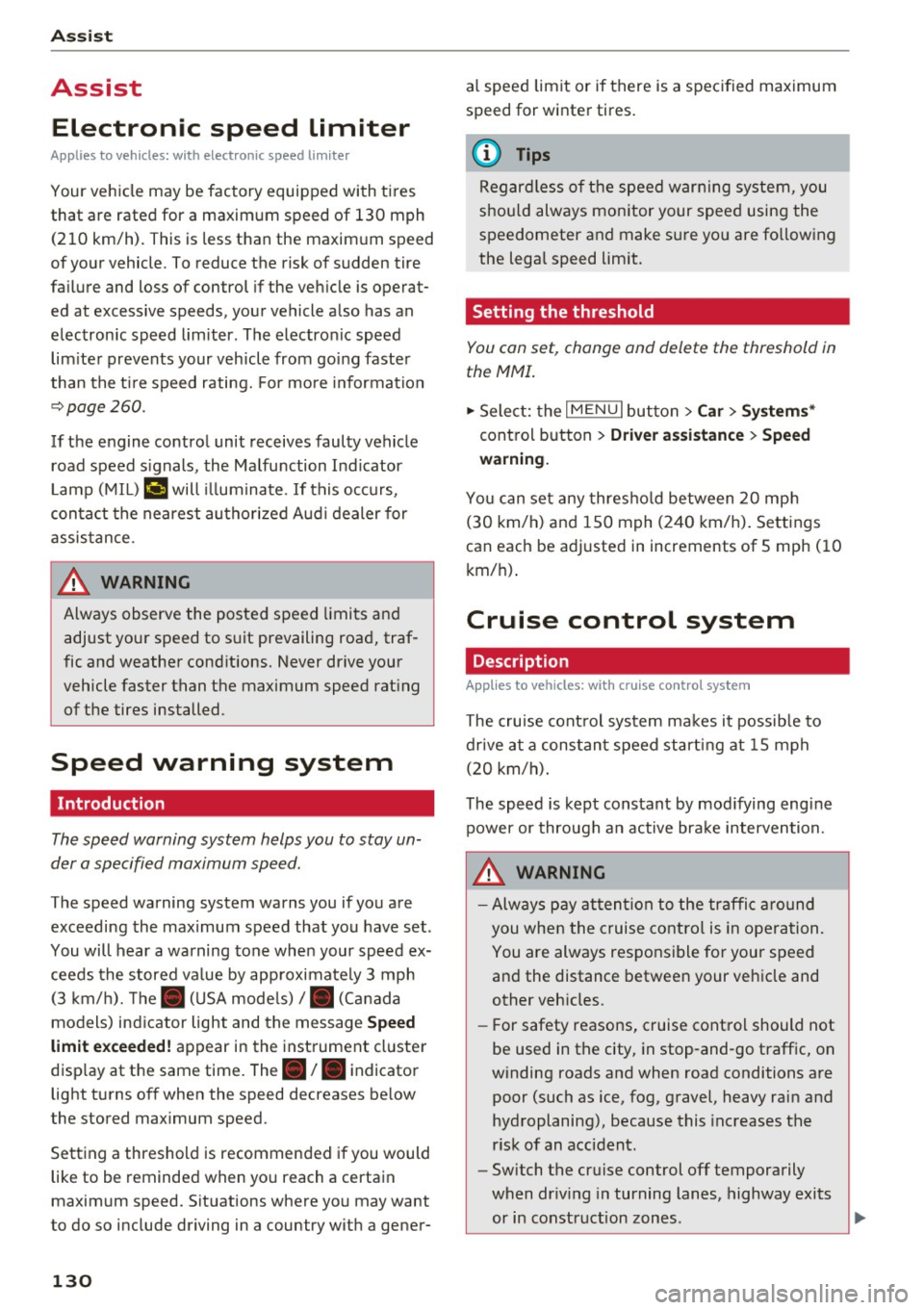
Ass is t
Assist
Electronic speed limiter
Applies to vehicles: with electronic speed limite r
Your vehicle may be factory equipped wi th tires
that are rated for a maximum speed of 130 mph (210 km/h). This is less than the maximum speed
of your vehicle. To reduce the risk of sudden tire
fa ilure and loss of control if the veh icle is operat
ed at excessive speeds, your vehicle also has an
electron ic speed limiter. The electron ic speed
lim iter prevents your veh icle from going faster
than the t ire speed rating. For mo re information
~page 260.
If the engine control unit receives faulty vehicle
road speed s ignals, the Ma lfunction Ind icator
L amp (MIL)
¢;5 will illum inate. If this occurs,
con ta ct the nearest au thori zed A ud i d ealer for
assis tance.
A WARNING
Always observe the posted speed limits and
adjust your speed to s uit prevailing road, traf
fic and weather cond itions. Never drive your
vehicle faster than t he maximum speed rat ing
of the tires installed.
Speed warning system
Introduction
The speed warning system helps you to stay un
der a specified maximum speed.
-
The speed warning system warns you if you are
exceeding the maximum speed that you have set .
You will hear a wa rning tone when your speed ex
ceeds the stored va lue by app roxima tely 3 mph
(3 km/h). The. (U SA mode ls)/ . (Canada
models) ind ic a tor light and the message
Speed
limit e xceeded!
appear in the inst rument cluste r
disp lay at the same time. The./. indicato r
light t urns off when the speed decreases be low
the stored maximum speed.
Se tting a thresho ld is recommended if you would
like to be reminded when yo u reach a certain
maximum speed. Situations where you may want
to do so include driving in a country wit h a gener-
130
al speed limit or if there is a spec ified maximum
speed for winter tires.
(D Tips
Regar dless o f th e speed war ning system, you
shou ld always monitor your spee d using the
speedometer and make s ure yo u are fo llow ing
the legal speed limit .
Setting the threshold
You can set, change and delete the threshold in
the MMI .
.. Sele ct: the I M ENU I button >Car > Systems*
control button > Drive r assi stance > Speed
wa rning.
You can se t any thresho ld between 20 mp h
(3 0 km/h) and 150 mph (2 40 km/ h). Settings
can each be adj usted in increments of S mph ( 10
km/ h).
Cruise control system
· Description
Applies to vehicles: with cruise control system
The cru ise cont rol system ma kes it possib le to
dr ive at a constan t speed starti ng at 15 mph
(2 0 k m/h).
The speed is kep t constant by mod ifying engine
power or through an active bra ke interven tion.
A WARNING
- Always p ay att ention to the tr affi c ar ou nd
you whe n the cruise co ntro l is in opera tion.
Y ou are always responsible fo r your speed
and the distance between your veh icle and
other vehicles.
- For safety reasons, cruise cont rol should not
be used in the city, in stop-and-go traff ic, on
winding roads and when road conditions a re
poor (such as ice, fog, g ravel, heavy ra in and
hyd roplaning), because this inc reases the
ris k of an accident.
- Switch the cruise control off temporarily
when dr iv ing in turning lanes, highway exits
or in constr uct ion zones.
-
Page 135 of 328
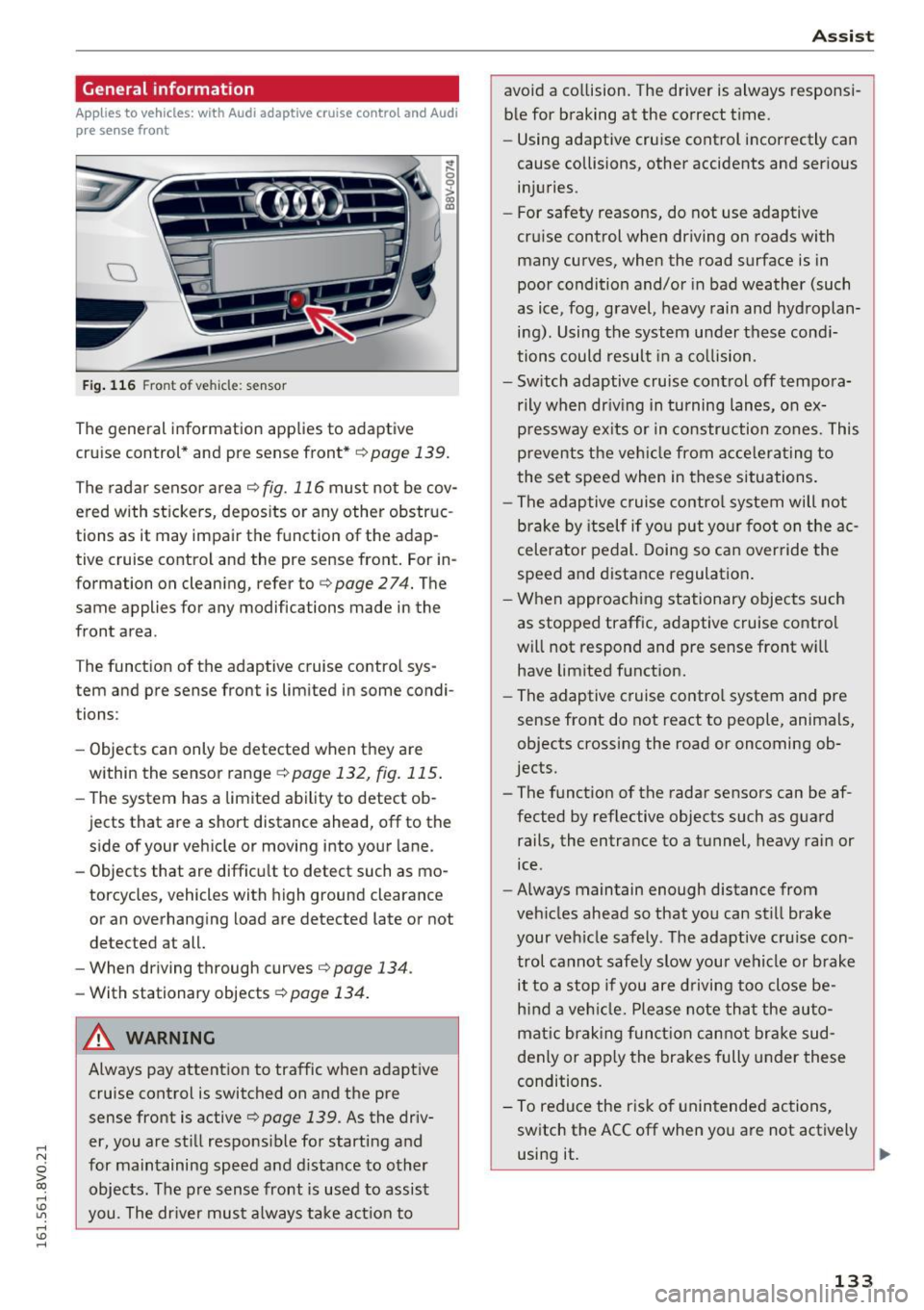
.... N
ci > CX)
.... I.Cl U"I
.... I.Cl ....
General information
Appl ies to vehicles: with Audi adaptive cruise contro l an d Audi
p re se nse front
Fig. 116 Front o f ve hicle: sensor
The general information applies to adaptive
cruise control* and pre sense front*¢
page 139.
The radar sensor area¢ fig. 116 must not be cov
ered with stickers, deposits or any other obstruc
tions as it may impair the function of the adap
tive cruise control and the pre sense front. For in
formation on cleaning, refer to
c:> page 2 74. The
same applies for any modifications made in the
front area .
The function of the adaptive cruise control sys tem and pre sense front is limited in some condi
tions :
- Objects can only be detected when they are
within the sensor range
¢ page 132, fig. 115.
- The system has a limited ability to detect ob
jects that are a short distance ahead, off to the side of your vehicle or moving into your lane.
- Objects that are difficult to detect such as mo
torcycles, vehicles with high ground clearance
or an overhanging load are detected late or not detected at all.
- When driving through curves
c:> page 134.
-With stationary objects c!;> page 134.
A WARNING
Always pay attention to traffic when adaptive
cruise control is switched on and the pre
sense front is active
c:> page 139 . As the driv
er, you are still responsible for starting and
for maintaining speed and distance to other objects. The pre sense front is used to assist
you. The driver must always take action to
Assist
avoid a collision. The driver is always responsi ble for braking at the correct time.
- Using adaptive cruise control incorrectly can
cause collisions, other accidents and serious
injuries.
- For safety reasons, do not use adaptive
cruise control when driving on roads with
many curves, when the road surface is in
poor condition and/or in bad weather (such
as ice, fog, gravel, heavy rain and hydroplan
ing) . Using the system under these condi
tions could result in a collision.
- Switch adaptive cruise control off tempora
rily when driving in turning lanes, on ex
pressway exits or in construction zones. This
prevents the vehicle from accelerating to
the set speed when in these situations.
- The adaptive cruise control system will not
brake by itself if you put your foot on the ac
celerator pedal. Doing so can override the
speed and distance regulation.
- When approaching stationary objects such
as stopped traffic, adaptive cruise control
will not respond and pre sense front will
have limited function.
- The adaptive cruise control system and pre
sense front do not react to people, animals,
objects crossing the road or oncoming ob
jects.
- The function of the radar sensors can be af
fected by reflective objects such as guard
rails, the entrance to a tunnel, heavy rain or
ice .
- Always maintain enough distance from
vehicles ahead so that you can still brake
your vehicle safely . The adaptive cruise con
trol cannot safely slow your vehicle or brake it to a stop if you are driving too close be
hind a vehicle. Please note that the auto
matic braking function cannot brake sud
denly or apply the brakes fully under these
conditions.
- To reduce the risk of unintended actions,
switch the ACC off when you a re not actively
using it.
~
133
Page 137 of 328
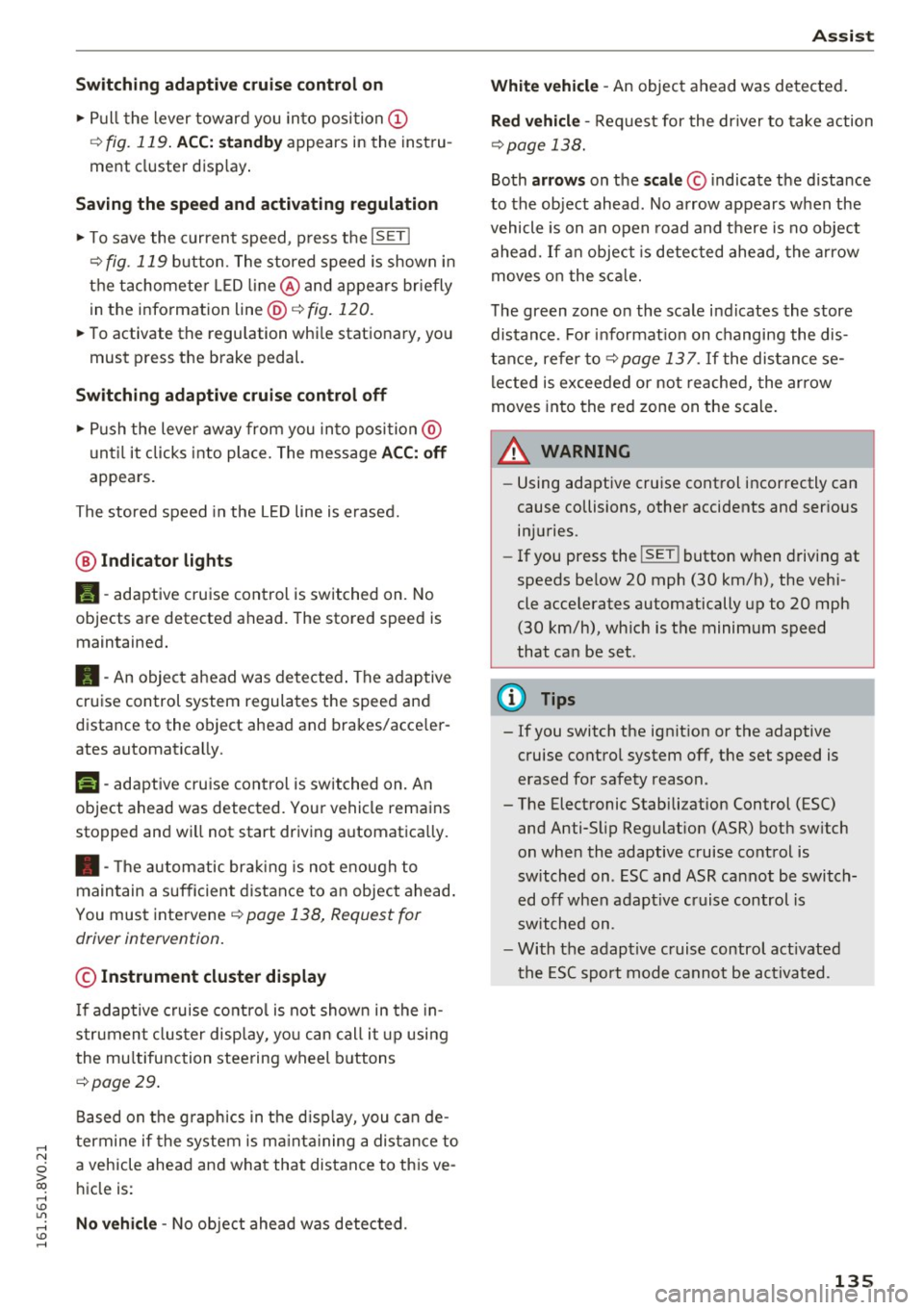
,....,
N
0 > co ,....,
"' Pull the lever toward you into position @
¢fig. 119 . ACC: stan dby appears in the instru
ment cluster disp lay .
Saving the speed and activating regulati on
"'T o save the c urrent speed , press the ISETI
¢fig. 119 button. The stored speed is shown in
t h e tachomete r LED line @and appears briefly
in the information line @¢
fig. 120.
"' To activate the regu lation whi le stationary, you
must press the brake pedal.
Sw itching adaptiv e cruis e control off
"' Push the lever away from you into position @
until it clicks i nto place. The message
AC C: off
appears .
The stored speed in the LED line is erased.
@ Indicato r lights
II -adaptive cruise control is switched on. No
objects are detected ahead. The stored speed is
maintained.
• -An object a head was detected . The adaptive
cruise control system regulates the speed and
d istance to the object ahead and brakes/acce ler
ates automatica lly.
fij -adaptive cru ise control is switched on. An
object ahead was detected. Your vehicle remains
stopped and w ill not start driving automatica lly.
• -T he automatic bra king is no t enough to
maintain a sufficient distance to a n object ahead.
You must intervene ¢
page 138, Request for
driver intervention.
© Instrument clu ster display
If adaptive cruise control is not shown in the in
s trument cluster disp lay, yo u can call it up using
the mu ltifunction steering wheel b uttons
¢ page 29 .
Based on the g raph ics in the d isp lay, you can de
termine if the system is m ainta ining a distance to
a vehicle ahead and what that distance to this ve
hicle is:
No vehi cle -No object ahead was detected.
Assist
White vehicl e -An object ahead was de tected .
Red vehicl e -Request for the dr iver to take action
¢page 138.
Both arrows on the scal e© indicate the d istance
to the object ahead . No arrow appears when the
vehicle is on an open road and t here is no object
ahead. If an object is detec ted ahead, the a rrow
moves on the sca le.
T he green zone o n the scale indicates the store
distance. For informat ion on changing the dis
t a nce, refer to ¢
page 13 7. If the distance se
l ected is exceeded or not reached, the arrow
moves into the red zone on the scale.
A WARNING
- Using adaptive cruise control incorrectly can
cause collisions, other accidents and ser ious
in ju ries.
- If you press the
!SET ! button w hen driving at
speeds be low 20 mph (30 km/h), the vehi
cle acce lerates automatically up to 20 mph
(30 km/h), wh ich is the minimum speed
that can be set.
{!) Tips
- If you switch the ignit ion or the adaptive
cruise control system off, the set speed is
erased for safety reason.
- The Electronic Stabilization Control (ESC) and Anti-S lip Regulat ion (ASR) both sw itch
on when the adaptive cruise control is
switched on . ESC and ASR ca nnot be switch
ed off when adapt ive cruise control is
switched on.
- With the adaptive cruise control act ivated
t he ESC spo rt mode cannot be activated.
135